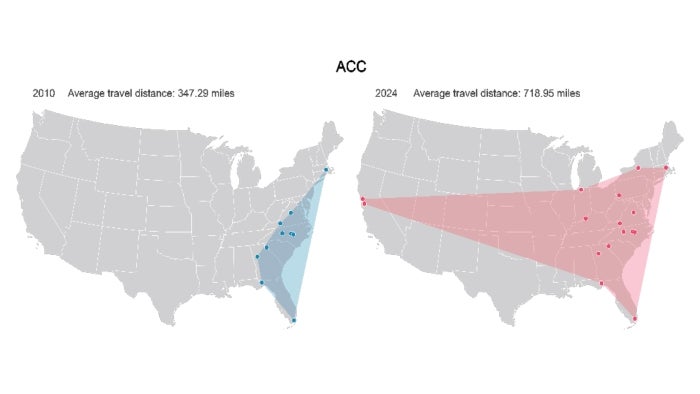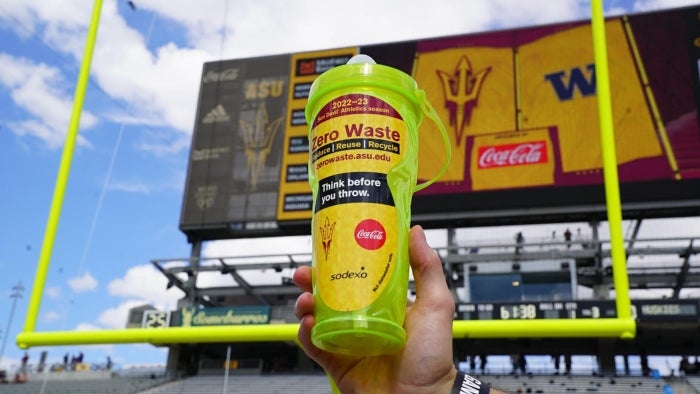Students calculate the carbon costs of Power Five shakeup

Computer science researchers have determined that recent changes in collegiate football conference alignments might double carbon emissions. Sun Devil Football wide receiver Coben Bourguet (shown above) is an honors student in the Ira A. Fulton Schools of Engineering. While he notes the issues related to increased travel, he thinks athletes have a powerful, impactful voice in raising awareness of sustainability and that engineers will provide helpful solutions. Image courtesy Coben Bourguet
Each year, Arizona State University alum and dedicated college football fan Michael Allor makes the trek to Seattle with his brother David, a University of Washington grad, to watch the Sun Devils face off against the Huskies.
“It’s always been a good way to connect with my brother,” Allor says. “We have a bit of a friendly rivalry. It’s a nice tradition.”
At least, it used to be.
Changes to the structure of the Power Five — the term that refers to the top athletic conferences in the National Collegiate Athletic Association, or NCAA — mean that the Sun Devils and the Huskies will never play each other in the regular season.
Computer science research students in the School of Computing and Augmented Intelligence, part of the Ira A. Fulton Schools of Engineering at ASU, have crunched the numbers.
They’ve concluded some conference realignments will almost double carbon emissions.
Jiayi Hong, a postdoctoral research scholar who conducts research in the Center for Accelerating Operational Efficiency, and Sia Sheguri, an undergraduate computer science student, worked under the supervision of Ross Maciejewski, director of the School of Computing and Augmented Intelligence, to calculate the annual carbon footprint of college football teams after the conference realignments.
They have released the findings in a new paper titled “Carbon Emission in Football Games,” which was published in the March edition of the Sustainability and Sports Science Journal.
Carbon emissions refer to the amount of carbon dioxide released into the air, especially by car and jet engines. Carbon dioxide is a greenhouse gas that traps heat in the atmosphere, contributing to climate change. Experts believe that air travel alone accounts for about 4% of the planet’s global warming. Due to the longer travel distances associated with the conference changes, teams will fly more to get to their opponents’ football stadiums.
Since it’s impossible for all college football teams to play each other, schools formed conferences, or groups of teams who agree to meet on the field during the regular season. The first conference, the Big Ten, was formed in Chicago in 1895 and included Midwestern teams such as Purdue University, the University of Michigan and the University of Minnesota. Because, in that era, long-distance travel was so expensive and impractical, early conferences focused on creating organizations of neighboring teams.
Today, with the ready availability of air travel, football teams are free to move across longer distances. The recent movement of teams from one Power Five conference to another has created the potential for significant increases in carbon emissions due to new travel requirements.
ACC football teams will travel from sea to shining sea
The current shakeup began with the decision of USC and UCLA to leave the Pac-12 and join the Big Ten. The teams sought to leverage the value of the Los Angeles market to gain a greater share of television broadcasting revenue than other universities.
When they left, the remaining Pac-12 teams, such as the Sun Devils, were forced to consider how they would balance getting fans access to great games, provide competitive opportunities for players and ensure that their schools received a fair share of incoming revenue.
As a result of the changes, teams from Stanford University and the University of California at Berkeley joined the Atlantic Coast Conference, or ACC. It was this conference that saw the most significant increase in carbon emissions, which the researchers believe will nearly double.
“We expected that there would be differences, but the drastic changes were surprising,” Hong says. “We saw that the increases were so significant. For the ACC, the average travel distance more than doubled.”
Hong and Sheguri calculated that the Big 12, which Sun Devil Football will join, will have a more modest 23.65% increase in emissions.
Hong also notes that their research focused on team travel only. If fans make the longer trips with their teams, the increase in carbon emissions could be even greater.
Marcus Williams, senior associate athletic director of Sun Devil Athletics, says ASU remains mindful of these issues.
“No question our miles traveled have changed with the move to the Big 12, but we were trending in the right direction as Pac-12 travel could be longer than most conferences,” Williams says. “The college athletics business has changed, but we can’t lose sight of being smart in the sustainability world.”
Engineering a more sustainable game
The student researchers hope that computer engineering might offer helpful solutions for the future.
“Our next step of the project is to study planning solutions where we use computer science to help teams minimize carbon emissions,” Sheguri says.
It might be possible to create software that gives athletic coaching staff and teams easy-to-use, collaborative planning tools that help organize matches between teams with shorter travel distances. Studying the travel habits of fans, measuring that impact and finding ways to offset those carbon emissions is also an area for future computer science research.
Sun Devil wide receiver Coben Bourguet, an engineering management student in the Fulton Schools who graduates with honors in May, believes that such tools would be welcome with the team’s management and with players.
Sun Devil Football is focused on sustainability, winning multiple awards. The team partnered with Adidas to create a shoe made of Primegreen, a high-performance recycled material. They have held zero-waste home football games, encouraged fans to use green practices when tailgating and Mountain America Stadium, home of the ASU Sun Devils, is a LEED Gold-certified facility.
Bourguet says that players are encouraged to learn about these issues and find ways to effect positive change.
“ASU Football offers great resources to players, like guest speakers on important topics, leadership training through the Tip of the Fork (program) and lots of opportunities to get involved and help get stuff done,” Bourguet says.
Despite the findings, Maciejewski believes that college athletics can play a pivotal role in efforts to reduce the effects of climate change.
“The popularity of Sun Devil Football gives the team a platform to raise public awareness about environmental sustainability,” he says. “They can reach a wide audience and foster cooperation.”
Bourguet thinks that the players are up to the task and says that Head Coach Kenny Dillingham encourages them to think of themselves as role models. Plus, as an engineer himself, Bourguet is especially interested in how technology can be used in an impactful way in athletics.
“I try to be conscious of every decision I make and how it affects those around me,” Bourguet says. “A pivotal part of our program and our culture is making sure that the standards we set are the right standards.”
Williams agrees that this is an important part of the athletics culture at ASU.
“We will continue to do our part and teach and educate our players the importance of being accountable in this area,” Williams says. “We have close to 700 student-athletes across all sports, and each of them can do their part to do the right thing each and every day in big and small ways.”
Meanwhile, the project provided a special, collaborative research opportunity for Sheguri, who will now have a scholarly publication credit to her name — a relatively rare feat for an undergraduate.
“It was a really enriching experience,” Sheguri says. “The work allowed me to see how computer and data science might shine a light on an important issue and, hopefully, create change.”
More Science and technology

ASU-led space telescope is ready to fly
The Star Planet Activity Research CubeSat, or SPARCS, a small space telescope that will monitor the flares and sunspot activity of low-mass stars, has now passed its pre-shipment review by NASA.…

ASU at the heart of the state's revitalized microelectronics industry
A stronger local economy, more reliable technology, and a future where our computers and devices do the impossible: that’s the transformation ASU is driving through its microelectronics research…

Breakthrough copper alloy achieves unprecedented high-temperature performance
A team of researchers from Arizona State University, the U.S. Army Research Laboratory, Lehigh University and Louisiana State University has developed a groundbreaking high-temperature copper alloy…




